Notes
The Delicate Balance of Style Photos from War-Torn South Sudan
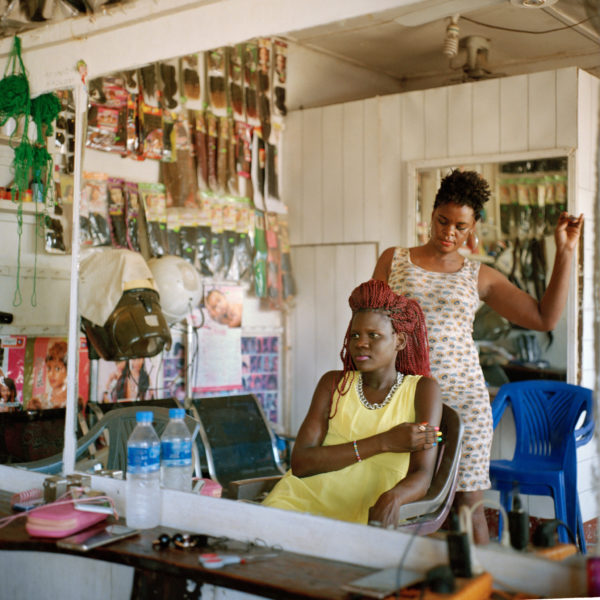
I see them from the perspective of another person in the salon, as if I am watching in the mirror as the woman next to me is getting her hair done. The stylist is focused on her work; the customer is focused on her reflection in the mirror. Waiting, there is nothing for me to do but note the details of my surroundings and observe their little duet.
This photo, in which Nadia Tushabe works on the bright red braids of Hariet Aroma, appeared in a recent feature in the ‘Style’ section of the New York Times. The story, entitled “What War Can’t Destroy,” shot in Juba, South Sudan. South Sudan is the world’s youngest country and consistently ranks among its most violent. The story argues, and the pictures seem to prove, that despite the duration and pervasiveness of internecine conflict, South Sudanese people retain a “fearless sense of style.”
The purpose of the story, then, is to showcase that look to the well-heeled readership of the Style section. The photo of Tushabe and Aroma is rich with arresting detail: the light reflected off the plastic-wrapped hair extensions hanging on the wall, the large silver hoop earrings that frame Tushabe’s face, the five different colors on Aroma’s nails. But its perspectival framing serves as a reminder of the spectator’s contradictory place: simultaneously brought close by the camera, but always off to the side, detached and watching.
Virtually all of the photos in the story, like this one, are shot in walled spaces. The author notes that, because of the pervasive militarization of South Sudanese life and the suspiciousness of the South Sudanese government, it is virtually impossible, and functionally illegal, to take photographs on the street. This prohibition results in more intimate-seeming photos of the subjects, who generally appear either indoors in places like barbershops, salons, and performance venues, or enclosed outdoor spaces, hemmed in by buildings or trees. It also results in a severing of subjects from their environments and the larger contexts in which their lives unfold.
In one photo, a mother and her daughter sit on a motorcycle under a tree – they are listening to a Catholic sermon, and a solid fence in the background provides that sense of enclosure.
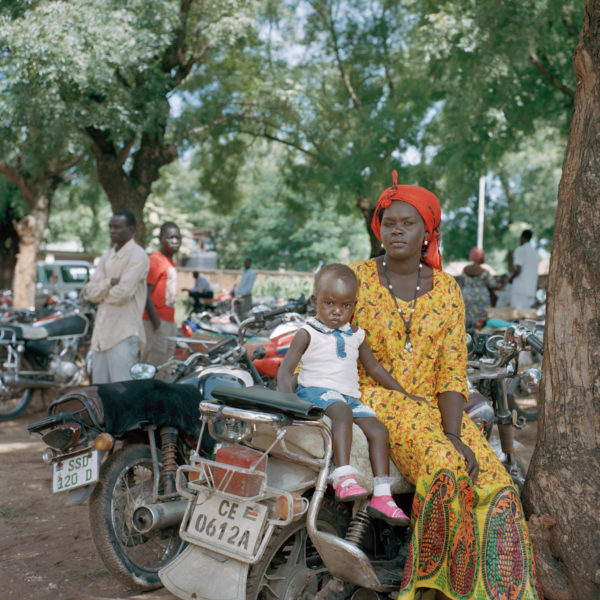
The bike is dusty, and the little girl’s white shirt and white socks, with their lacy trim, are improbably clean by contrast, and likewise her pink Mary Jane shoes. Her face is serious, almost severe, while her mother’s is more neutral, but faint frown lines between her eyebrows suggest a long habit of suppressed worry. But her hair is wrapped and tied in a scarf shaded a perfect Pantone orange, a color echoed in the pattern of her yellow dress. Her necklace, earrings, and bracelet all match, and her whole ensemble is a study in visual interest.
In keeping with the portrait style of these photographs, the focus on the woman and her child leaves the background hazy. We can see other people, other vehicles, other trees, but their impressions are a little blurry and their edges are soft: almost an invitation not to look beyond the female figures at the center of the composition, and so not to think too much about what else is happening. The violence that saturates this landscape is downplayed, except to the extent required to keep the photos compelling.
The one exception to the pattern of photographing people in confined spaces is an image featuring a group of women in the ‘United Nations Protection of Civilians site.’
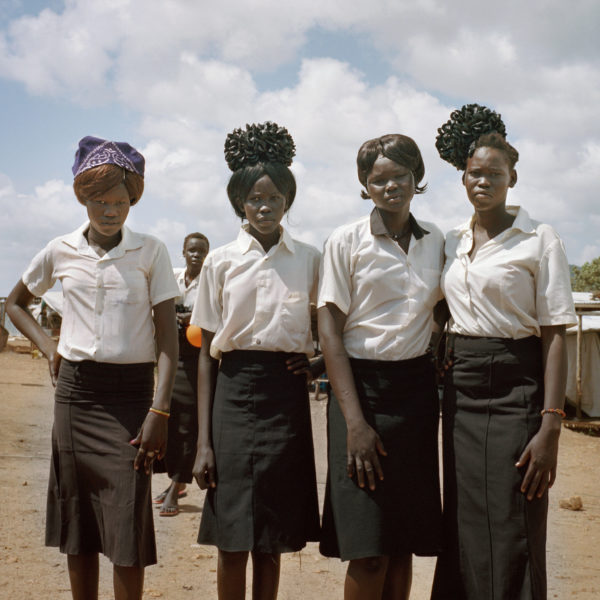
In this photo, we can see the sky above and the ground as it recedes toward the horizon, which makes for a somewhat roomier image, but the location implies a different kind of confinement, as do the makeshift structures that crowd the edges of the frame. These women are dressed simply in short-sleeved white blouses (some looking a little dingy) and modest black skirts, but the lines of their clothes are smart and their hair is carefully done, while the cant of their heads, shoulders, and hips suggests an eagerness be photographed. A few paces behind them, another woman looks curiously, even eagerly toward the camera, as if she wants to be included in whatever is happening.
Indeed, all of the subjects of these photographs seem to appreciate being regarded in this way. The text accompanying them bears this out, vouching that nearly everyone the photographer approached was “willing” to participate in this visual exchange. Elsewhere in the article, the photographer surmises that her images reveal truths about their subjects—specifically their losses and their griefs—that they would never yield in interviews. This possibility is part of what makes the photos compelling, but also begets a cluster of ethical questions. First, if the subjects themselves are reluctant to speak about their traumas, what are the politics of ascribing those traumas onto their photographic likenesses? To what extent does this ascription override their own motivations for being photographed? And how might the camera become coercive, if it elicits confessions from photographed people that they would not willingly have given up otherwise?
And where does that leave us, as spectators? There is a dilemma inherent in any kind of image that depicts creativity, resilience, or ingenious survival in the context of militarized violence. On the one hand, such pictures remind us that the people who live under these conditions daily are more than victims of circumstance: they are people with desires and stories and preferences and personalities. But how can we appreciate these displays of agency (manifested in Juba as a commitment to loveliness, to beauty, to ‘style’) while maintaining an awareness of the invisible violence that structures the scenes and the everyday lives of these people?
The placement of these photos in the Style section solicits a certain kind of looking while precluding other gazes. By inviting spectators to see the South Sudanese people as something other than the face of a crisis, the photos offer an alternative to the cloying oppressiveness of the Western humanitarian gaze. And by emphasizing a common human impulse to “look good,” and insisting that “War or not, the South Sudanese are like everyone else” because they share it, the article encourages appreciation and identification instead of pity.
But at the same time, by inviting us to look in this way, the images also license us to forget about this ongoing crisis, and to adopt a vantage similar to that of the invisible bystander in the beauty shop: admiring, intrigued, and distant.
For example, in one photo, two young men, identified as Silva and Eric, pose on a stone ledge. Eric perches with his leg outstretched, while Silva crouches next to him; Silva has an arm tossed carelessly across Eric’s shoulder, and Eric’s bicep rests on Silva’s knee.
The image is all patterns: the blue crosshatch of the grate on the windows behind them, the stone and mortar of the wall, the colorful geometry of their clothes, the smooth interlocking of their bodies. The caption tells us simply that they are “wearing clothing made from traditional African textiles.” Their faces are inscrutable, almost expressionless, but for slight downward turns of both their mouths. Silva’s eyes are heavy-lidded, obscuring the direction of his gaze, while Eric looks directly at the camera but does not seem to register any emotion. They have consented to being posed, and photographed, but betray nothing more than that.
Elsewhere in the article, the photographer surmises that her images reveal truths about their subjects—specifically their losses and their griefs—that they would never yield in interviews. This possibility is part of what makes the photos compelling, but also begets a cluster of ethical questions. First, if the subjects themselves are reluctant to speak about their traumas, what are the politics of ascribing those traumas onto their photographic likenesses? To what extent does this ascription override their own motivations for being photographed? And how might the camera become coercive, if it elicits confessions from photographed people that they would not have willingly given up otherwise?
And where does that leave us, as spectators?
There is a dilemma inherent in any kind of image that depicts creativity, resilience, or ingenious survival in the context of militarized violence. On the one hand, such pictures remind us that the people who live under these conditions daily are more than victims of circumstance: they are people with desires and stories and preferences and personalities. But how can we appreciate these displays of agency (manifested in Juba as a commitment to loveliness, to beauty, to ‘style’) while maintaining an awareness of the invisible violence that structures the scenes and the everyday lives of these people?
The placement of these photos in the Style section solicits a certain kind of looking while precluding other gazes. By inviting spectators to see the South Sudanese people as something other than the face of a crisis, the photos offer an alternative to the cloying oppressiveness of the Western humanitarian gaze. And by emphasizing a common human impulse to “look good,” and insisting that “War or not, the South Sudanese are like everyone else” because they share it, the article encourages appreciation and identification instead of pity. But at the same time, by inviting us to look in this way, the images also license us to forget about this ongoing crisis, and to adopt a vantage similar to that of the invisible bystander in the beauty shop: admiring, intrigued, and distant.
— Rebecca Adelman
Photos: Sarah Hylton for the New York Times Caption 1: Nadia Tushabe, the owner of Galaxy salon in Juba, styles Hariet Aroma’s Hair; Caption 2: A mother and her daughter sit on a motorcycle while listening to a sermon outside of St. Joseph’s Catholic Church in Juba; Caption 3: Young women in the United Nations Protection of Civilians site in Juba after church. More than 38,000 people are seeking shelter in the camp because of widespread insecurity across South Sudan.
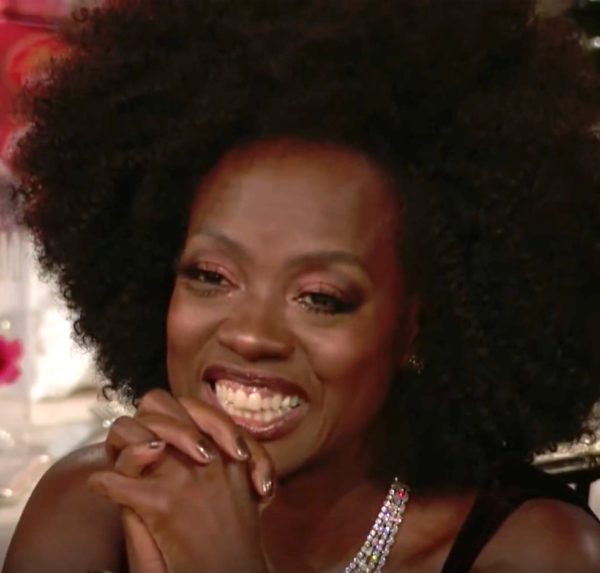
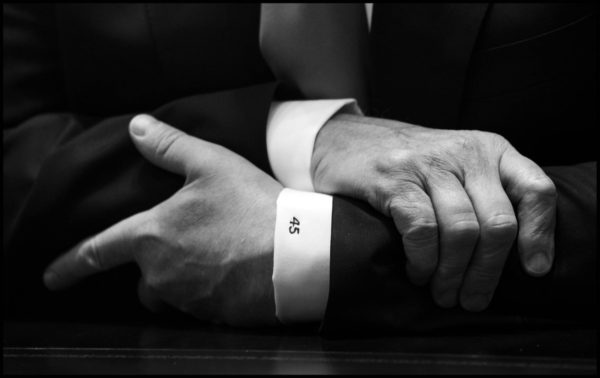
Reactions
Comments Powered by Disqus